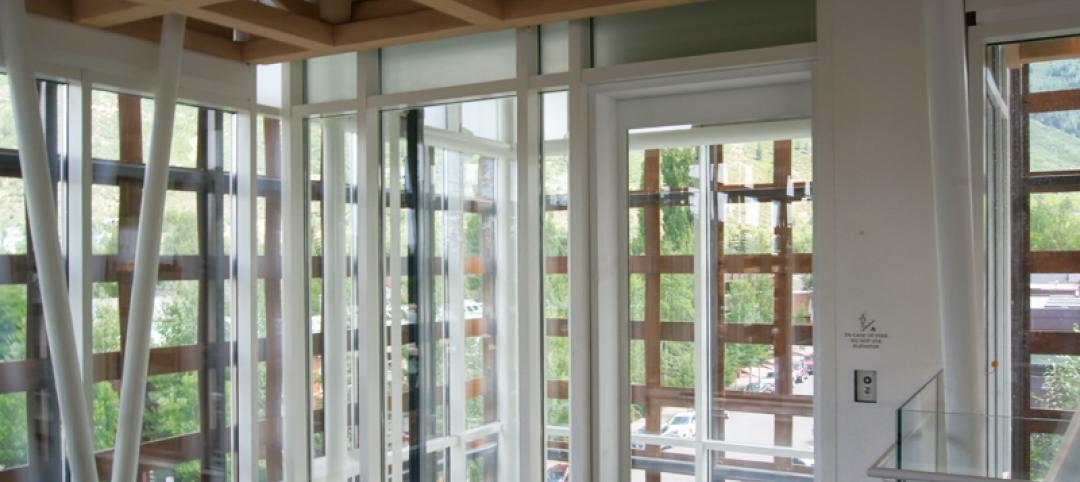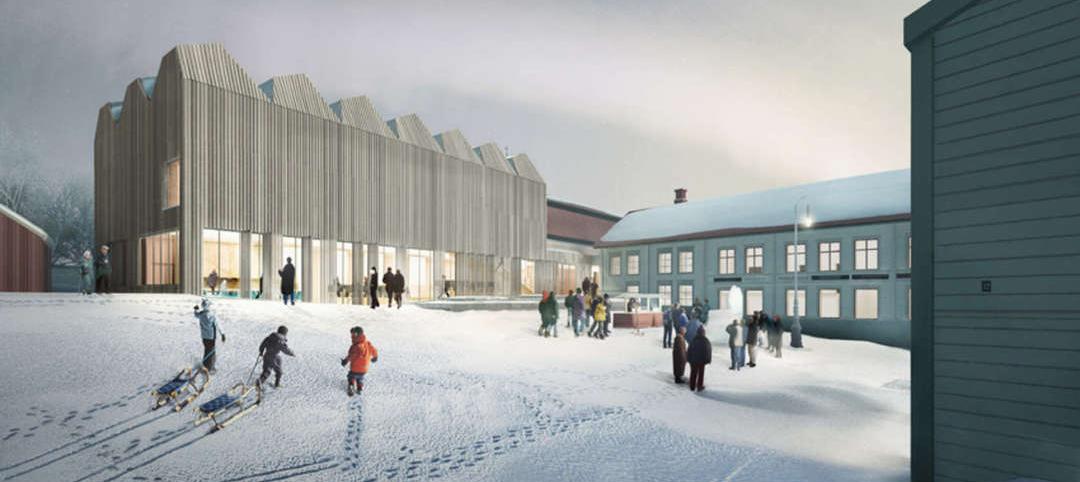A new museum, located on Liberty Island in New York Harbor—with stunning views of the 151-ft-tall Statue of Liberty on the island and the 1,792-ft-tall Freedom Tower in Lower Manhattan—presents visitors with the opportunity to contemplate the changing meaning of liberty in the United States.
Opening officially on Thursday, the 26,000-sf, $70 million Statue of Liberty Museum was designed by FX Collaborative and built by Phelps Construction. The interiors of its three exhibit spaces were created by ESI Design, and include the statue’s original torch, which was relocated from the statue’s base.
The Statue of Liberty-Ellis Island Foundation worked with the National Park Service to create the museum, and provided funding for the building, which had been in the works for about five years, says Daniel Piselli, AIA, LEED AP, CPHD, Director of Sustainability for FX Collaborative. (A time-lapse video of the museum's construction, created by EarthCam, can be viewed here)
Liberty Island attracts 4.3 million visitors annually. A smallish museum that opened within the statue’s pedestal in the 1980s could accommodate only about 20% of its daily traffic. “So one of the goals [for the new museum] was to provide people with more access to the statue’s history,” says Nick Hubbard, ESI Design’s content and activity designer.
The artifacts on display include sculptor Frédéric Auguste Bartholdi’s model for the statue; other working models in plaster, wood, and copper (300 plates of which were used to construct the statue); and lottery tickets sold in France to pay for the statue, a gift from that country to the U.S. (shipped in 350 pieces inside 214 crates) that was dedicated on October 28, 1886.

The statue's original torch needed to be disassembled into two pieces in order to move it from the statue's pedestal to the museum's Inspiration Gallery, one of three exhibit spaces. Image: David Sundberg/Esto
The new museum has three exhibit spaces:
•Immersive Theater, in three sections, each 1,000 sf. The first and third sections are 13 ft high, the second 20 ft high. The theaters include massive curved screens with high-def (8K-resolution) projection. The first section focuses on the past, with archival photos and graphics. The second on the construction, with newer footage that includes drone-captured imagery. And the third on the future of the statue and the island, which includes a scheduled beautification program.
•The Engagement Gallery (where most of the artifacts reside).
•The Inspiration Gallery, which is where the original torch now rests. In order to relocate the torch, it had to be disassembled into two pieces and trucked over from the statue’s pedestal.
Hubbard says that ESI “always tries to start with a core narrative that’s site-specific.” In the museum’s case, the metaphor that drives the exhibits is the changing meaning of liberty.
An interactive sketchbook shows Bartholdi’s original drawings for the statue. Visitors to the Inspiration Gallery can document their visit by taking selfies of themselves and merging those shots with different “liberty” images that are then combined and projected onto a 40-ft LED screen “that creates a mosaic,” says Hubbard, and is constantly changing.
The anticipated stay per visitor inside the museum is about 45 minutes. The exhibits are nonlinear, so visitors and start and stop wherever they want. Given that at least half of the island’s visitors are from other countries and might not speak English, ESI made the exhibits even more visual than it normally would. The exhibits include touch models of the statue’s face and foot. “There are all kinds of ways for people to engage the museum,” says Hubbard.

Visitors can take selfies of themselves and marry those images to different symbols or icons of “liberty” that thenn get projected onto a giant screen that creates a mosaic. Image: Keena Photo

The museum is replete with interactive displays that allow visitors to engage in the statue's history. Image: Keena Photo
Dealing with a tight jobsite surrounded by water
The museum is located at the island’s north tip, on land that once was used for housing (before the September 2001 terrorist attack on the World Trade Center, the park’s superintendent lived on the island), and a Coast Guard barracks that was damaged during Superstorm Sandy in October 2012 and subsequently demolished.
“This project had more logistical issues than any I’ve been involved with previously,” says Doug Phelps, CEO of Phelps Construction, which was hired at the project’s preconstruction phase. The museum’s first floor (which is open, non-usable space) is elevated 10 feet above the island’s 500-year floodplain, and its precast walls have openings that allow sea water in and out.
Phelps says that the only cargo service to Liberty Island had been from the borough of Staten Island. On top of that, the Building Team was instructed that construction could not disrupt the park’s tourism. “We had a very small laydown area, so we had to build a temporary dock,” says Phelps. The construction favored precast concrete panels for the museum’s walls, and a lot of that concrete was poured offsite in Jersey City, N.J., where Phelps Construction had set up a barge. (At one point, Phelps recalls, there were 16 concrete mixers on the barge.)

Murals inside of the museum recreate the workshops in France where the statue was built. Image: Keena Photo
“The barging was a big undertaking,” says Phelps. “I know more about tides than I ever thought I would.”
Piselli of FX Collaborative adds that multiple materials were used to mitigate thermal breaks, such as fiberglass for penetrations on the roofdeck, and structural thermal breaks between the interior and exterior concrete slabs.
Because the job site took up a relatively small portion of Liberty Island’s 14.7 acres, the Building Team was limited in how much equipment it could use. “We had one forklift, one crane, and so forth, that everyone had to share,” says Phelps.
The site also had limited availability of underground utilities. Phelps explains that as the island has been expanded by fill over the years, previous construction and engineering teams just left the old seawalls up. So it took a lot of work on the part of the project’s structural engineer, DeSimone Consulting Engineers, to build new footings; Phelps says that something like 150 piles were driven into the site.
The National Parks Service mandates that all of its new buildings must achieve at least LEED Silver certification. The Statue of Liberty Museum was built to achieve LEED Gold. The Service also mandates that its buildings take into account bird migration. So fritt patterns are etched into the museum’s curtainwall to prevent aviary collisions.
Other energy- and water-saving features include the museum’s high-performance envelope and lighting, radiant heating, climate-controlled vitrines to reduce the building’s conditioning load, and its recycling and composting programs.
The museum’s water savings will be 43% over EPA’s baseline, and its energy savings 31% over ASHRAE 90.1 2007 levels. Ninety-two percent of the project’s construction waste was recycled of salvaged.
Piselli says that the integration of landscaping was part of the museum’s design “from the beginning,” and includes stormwater raingardens at grade, and a 14,000-sf green roof with sheltered earth and restored habitat native plantings. FX Collaborative designed the green roof in collaboration with Quennell Rothchild & Partners, which researched native plants and created four seed mixes for different plant areas for the roof, at-grade meadow, shaded meadow, and the 1,000-sf raingarden. The heights of plants and trees were considered to preserve the museum’s views.
Piselli notes that the entire museum’s design “considered the adjacencies to the Statue of Liberty” and site lines to Ellis Island and to Lower Manhattan.

The site lines to the statue, Ellis Island, and Lower Manhattan were important considerations in the design of the new museum, with sits on the northern tip of Liberty Island. The building's roof deck includes a 14,000-sf green roof. Image: David Sundberg/Esto
Related Stories
Museums | Apr 23, 2015
Moshe Safdie unveils pentagonal scheme for National Medal of Honor Museum
The new museum near Charleston, S.C., will archive the history of the nation's highest military honorees.
Museums | Apr 22, 2015
Check out Ralph Johnson's stunning nature-inspired Shanghai museum
The newly opened Shanghai Natural History Museum, designed by Perkins+Will’s Global Design Director Ralph Johnson, mimics the shape of a nautilus shell, and features natural elements throughout.
Museums | Apr 16, 2015
SANAA and Snøhetta tie at first place for Budapest museum bid
The two firms submitted designs for the New National Gallery and Ludwig Museum, one of five planned museums to be constructed in a park just outside the urban center of Hungary’s capital.
Sponsored | Fire-Rated Products | Apr 14, 2015
Fire resistive curtain wall brings maximum light, views and safety to Aspen Art Museum
The curtain wall used for the Shigeru Ban-designed museum provides maximum daylight while protecting the art from fire
Museums | Apr 10, 2015
Henning Larsen Architects designs timber museum extension in Sweden
The new extension will complement Österund’s wooded surroundings
Building Team Awards | Apr 10, 2015
14 projects that push AEC teaming to the limits
From Lean construction to tri-party IPD to advanced BIM/VDC coordination, these 14 Building Teams demonstrate the power of collaboration in delivering award-winning buildings. These are the 2015 Building Team Award winners.
Building Team Awards | Apr 9, 2015
9/11 museum triumphs over controversy
The Building Team for this highly visible project had much more than design, engineering, and construction problems to deal with.
High-rise Construction | Mar 16, 2015
Mexican Museum tower caught in turmoil to break ground this summer in San Francisco
Millennium Partners said it will break ground on the 53-story residential and museum tower while the lawsuits go through the appeals process.
Museums | Mar 9, 2015
Architecture based on astronomy principles for new planetarium in Shanghai
The ancient Chinese civilization left some of the earliest records of humans studying the stars and skies. To exhibit this long history, a new planetarium and astronomy museum is planned for construction in Shanghai.
Museums | Mar 5, 2015
A giant, silver loop in Dubai will house the Museum of the Future
The Sheikh of Dubai hopes the $136 million museum will serve as an incubator for ideas and real designs—a global destination for inventors and entrepreneurs.

















